Sorted by date Results 151 - 175 of 392
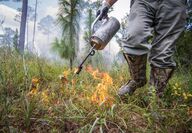
A prescribed burn is planned at Gulf State Park as part of a forest management plan associated with longleaf pine restoration, fuel reduction and invasive species control. The planned burn will take place in the Eagle Loop section of the park near Lake Shelby on November 20-21, 2024, weather permitting. State Park Road will be closed during the burn period. Every effort is being made to ensure safety and proper smoke management during this burn. However, park guests staying in the lakeside cabin...

November 15, 2024 - The Wildlife and Freshwater Fisheries (WFF) Division of the Alabama Department of Conservation and Natural Resources (ADCNR) has temporarily closed the three-lane ramp at the McFarland Public Boat Ramp (McFarland West) on Pickwick Reservoir in Florence for major upgrades. The facility's two-lane ramp (McFarland North) will remain open during the majority of the renovation period. During the closure the launching slab at McFarland West and the access pier at McFarland North...

November 22, 2024 - Andy Poss knows the Tennessee River's Pickwick Lake from top to bottom – literally. Fishing for both largemouths and the scrappy smallmouths, as well as crappie, is what he does now. For 15 years prior, he probed the lake from bottom to top to make a living. Poss was a commercial fisherman and mussel diver during those 15 years until, in his words, "I got tired of being wet all the time. And it's a lot of work to handle 2,000 hooks a day – baiting 1,000 hooks and then tak...

Many of my friends have been using every spare moment for the last several weeks, trying to fill their buck tag. Some are holding out for a certain deer, while others are not as picky. But no matter which type of hunter they are, there is one thing certain. Both are growing tired. The early mornings are becoming less exciting, and the cold weather makes even the preparation much more difficult. Some will lay their weapon down and wait until next year. For myself, I am also lingering a little lon...

In a continuing effort to minimize the spread of chronic wasting disease (CWD) in the state, the Alabama Department of Conservation and Natural Resources' (ADCNR) Wildlife and Freshwater Fisheries (WFF) Division held this season's first mandatory CWD check last weekend in Lauderdale County. WFF staff sampled 356 deer for CWD, a neurodegenerative disease that affects cervids, including white-tailed deer, at the sampling stations in Lauderdale County. In addition to samples from Lauderdale and...

December 6, 2024 - When some people harvest their first wild animal, it awakens an appreciation of the great outdoors and nature. For others, it is much more emotional and prompts memories of family or loved ones. For Sadie Pettus, the latter is true. On a recent hunting trip to Barbour Wildlife Management Area (WMA), Pettus was able to take a feral hog, and it evoked memories of her late father, Clark Crates. Although Crates was an avid outdoorsman as well as a talented musician on the piano,...
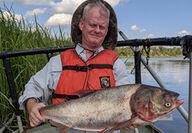
Dave Armstrong is planning to go hunting when the weather cools off, but he actually hopes he doesn't find an abundance of the species he's stalking. Armstrong is the Aquatic Nuisance Species Coordinator with the Alabama Department of Conservation and Natural Resources' (ADCNR) Wildlife and Freshwater (WFF) Division, and he and the Fisheries Section staff will be searching for several invasive carp species – silver, bighead, grass and black. Those carp, especially the silver, can be detrimental...

Believe it or not, if hunting were a company, it would be a Fortune 500 giant. In 2020, hunters and sport shooters pumped a whopping $149 billion into the U.S. economy. That's not pocket change—it's enough to make hunting the 52nd largest company by retail sales if it were listed on the Fortune 500, LandTrust reports. This money was spent on equipment such as shotguns and ammunition, trip-related expenses like lodging and transportation, licenses, leases, and more. But it's not just about s...

The Alabama Department of Conservation and Natural Resources (ADCNR) is offering a series of trapping education workshops during select weekends this fall and winter. The workshops provide instruction on the historical aspects of trapping, the biology of furbearers, and how to use trapping as a sound wildlife management tool. The workshops are open to anyone ages 7 and up. A $10 registration fee applies. To register, visit www.outdooralabama.com/trapping. Instruction begins on Saturdays with an...

October 18, 2024 - TALLAHASSEE, FL - Florida is still waiting for floodwaters to recede, but the scale of devastation through much of the sunshine state is clearly enormous after Hurricanes Helene and Milton struck the state in rapid fashion. The Florida Fish and Wildlife Conservation Commission is warning boaters that many of Florida's lakes and rivers are still hazardous. Boating restrictions remain in effect due to the flooding along the Suwannee/Santa Fe, St. Johns and Withlacoochee rivers...
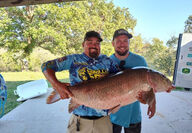
October 18,2024 - JEFFERSON CITY, Missouri. – The Missouri Department of Conservation (MDC) congratulates Ryan Young of Buffalo for swiping the latest state record for black buffalo. Young was fishing at Stockton Lake Oct. 13 when he caught a 55-pound, 9-ounce fish with his rod-and-reel. The previous state record under pole-and-line was a 53-pound black buffalo caught from Wappapello Lake in 1989. "I'm just in shock," Young said about his record. "It just shows you never know what you'll c...

Sarah Gibbs and Crystal Hightower hope last week's Ladies Tagging Workshop at the Weeks Bay Tonsmeire Resource Center is just the beginning of a trend on the Alabama Gulf Coast of female anglers gathering on a regular basis to hone their fishing skills and connect with fellow anglers – and sometimes help with research. Gibbs, a PhD student with Dr. Steven Scyphers in the Stokes School of Marine and Environmental Sciences at the University of South Alabama (USA), recruited Dauphin Island Sea L...
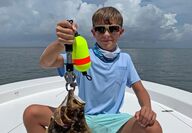
October 24, 2024 - MONTGOMERY - The Marine Resources Division (MRD) of the Alabama Department of Conservation and Natural Resources (ADCNR) reminds anglers that the recreational harvest of greater amberjack in federal and Alabama state waters closes November 1, 2024. Anglers landing red snapper, greater amberjack and gray triggerfish in Alabama are required to report their catch through Alabama's Snapper Check system. Red snapper season is currently open for 4-day weekends until the federal...
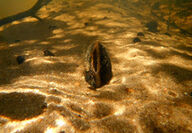
October 24, 2024 - Ever wonder why ensuring the survival of a small mollusk in a small creek in south Alabama is such a big deal? The main reason is those mussels are indicators of the quality of their environment, especially the water quality, which translates to the health of the entire ecosystem. That's why the Alabama Department of Conservation and Natural Resources' (ADCNR) Wildlife and Freshwater Fisheries (WFF) Division teamed up with the U.S. Fish and Wildlife Service (USFWS) and Monroe...
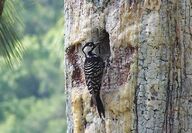
October 26, 2024 - WASHINGTON - The Department of the Interior today announced that the U.S. Fish and Wildlife Service is downlisting the red-cockaded woodpecker from endangered to threatened status under the Endangered Species Act. This milestone is the result of five decades of collaborative conservation efforts between the Interior Department, federal and state partners, Tribes, the private sector and private landowners that have resulted in increasing populations of these remarkable birds...

We had this six-pointer on camera several times. However, he was not just any six. The sheds from last year measured 135 inches. My first evening I chose the wrong stand. He showed up at a different one. For the next few days, I hunted where he was last seen, every morning and evening. He still lives. And I really wanted him. Oh, sure I would have been happy to put an arrow through some other giant. But this guy was different. This guy had a different story. This guy made the most out of the...

One of the benefits of hunting is getting to see so many different animals and other things that one just doesn’t get to see otherwise. I have renamed one of my trail cameras, the zoo camera, because it always has pictures of so many different kinds of animals. On that one camera, within the last two months, I have pictures of deer, coyotes, bobcats, turkeys, raccoons, squirrels, and a bear. Not to mention the various birds. And not only do you get to see various creatures, but sometimes i...

One of my least favorite things to see when bow hunting is a bunch of doe that comes in within fifty yards of my stand. I know that eventually I’m going to get busted. If I’m looking to take a doe, I might get a shot off. But no matter what, if they stay there long enough, I’m going to be discovered. It doesn’t matter if I’m wearing a deer hide underneath the best camo, while elevated thirty feet in the air, that one lone momma deer is going to sniff me out and let every other deer in three cou...
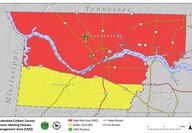
October 31,2024 - Under Alabama's Chronic Wasting Disease (CWD) Management Zone Regulation (220-2-.167), all deer harvested in the High-Risk Zone and the Buffer Zone of the state's CWD Management Zone (CMZ) must be submitted for CWD testing during specific weekends of the 2024-2025 white-tailed deer season. The mandatory sampling weekends in the High-Risk Zone of the CMZ are November 23-24 and December 7-8, 2024. The mandatory sampling weekends in the Buffer Zone of the CMZ are November 23-24,...

With landfills reaching capacity, what could be a better way to repurpose decommissioned equipment than using it to build habitat for Alabama's great offshore fisheries? Alabama Power Company recently teamed up with the Alabama Department of Conservation and Natural Resources' (ADCNR) Marine Resources Division (MRD) to take end-of-life concrete poles and tower segments to build a new reef in the (Conservation Commissioner) Christopher M. Blankenship Reef Zone that covers 65 miles of Gulf of...
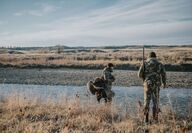
The intersection of political leanings and hunting participation presents an interesting paradox in American culture. Based on research from the land-sharing marketplace for outdoor recreation, LandTrust, this article explores the top 10 liberal and liberal-leaning states with the highest number of hunters per capita and the top 10 conservative and conservative-leaning states with the least number of hunters per capita, challenging common stereotypes about hunting and political affiliations. Top...

Coyotes are not a friend of any farmer, rancher, or hunter. They are equal opportunity predators. They will pursue your cat or your cattle. They are satisfied with fish or fowl. And they love a young tasty fawn. Needless to say, every opportunity to get rid of one should be taken. The rest of creation will thank you. There are however some places that make it a sport to hunt these scavengers. Texas is one. I have had a few opportunities to go with those who know how to call in these critters to...

My ground blind leaks. Yours does too. Yeah, I know you have the top-of-the-line, largest, most cushy, made-of-the-best-waterproof-material-blind money can buy. I’m sure it’s nice. But it leaks. It may not leak as much as mine. It may not leak in the same places as mine. But it leaks. Those leaks may not show up until the hardest rain, but, you know, it leaks. I’m sorry. It’s nothing to be ashamed of. You can still claim superiority in ground blind wars. But it leaks. And sometimes those l...
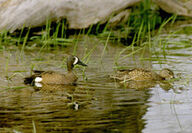
Although overall duck numbers are up in the latest Waterfowl Breeding Population and Habitat Survey, those waterfowlers who hunt the special teal season better plan to take full advantage of this year's early season of 16 days, set for September 14-29. Seth Maddox of the Alabama Department of Conservation and Natural Resources' (ADCNR) Wildlife and Freshwater Fisheries (WFF) Division said this year's survey indicated a downturn in blue-winged teal numbers, and the 2025 special teal season will...

Since 1973, the Alabama Department of Conservation and Natural Resources (ADCNR) has offered hunter education to anyone getting started on their hunting journey. Hunter education became mandatory in Alabama in 1993 for anyone born on or after August 1, 1977. The hunter education courses offered by ADCNR are designed for those with little to no hunting experience and emphasize hunter safety, hunting ethics and the important link between hunting and wildlife conservation. Alabama offers a variety...